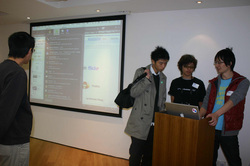 Introduction Social studies academic language and English language learners make for an interesting combination and challenge for social studies teachers with little experience working with English language learners. Teaching social studies to ELLs requires content area teachers to incorporate as much hands-on learning as possible in the classroom. Some Tips Connect ELL students’ cultures with what you are teaching. If you are discussing the different ways a culture manifests itself, such as dancing and artwork, encourage ELL students to talk about dancing or artwork in their culture. Have students work in small monolingual groups to produce a product in English, such as a poster or report to encourage them to think more about the content of the lesson than their English language usage. Incorporate strategies for test taking, note taking and study skills into lessons. For example, encourage students to look up synonyms of new social studies vocabulary or to analyze the words by understanding their roots, prefixes and suffixes. You might connect the root of a word with a student’s native language as well. For example, the term “patriarch” might be easier to understand if the student is a native Spanish speaker and can draw a connection between “padre” for father and the concept of “patriarch.” Use as many hands-on activities and visual aids in your explanations in class as possible. Social studies are full of abstract concepts that are best described in diagrams, pictures, globes and maps, for example. Also, create digestible texts for your social studies classes that contain all of the essential information for the lesson in bulleted lists to make it easier for ELL students to get the information they need without the extra unknown words. Pilgrims Give students a copy of a simplified version of the story of the Pilgrims. You might find one in a children’s encyclopedia. Have students pick out events that happened in the winter of 1620, the spring of 1621, the summer of 1621 and the fall of 1621. Tell students to highlight those events. Have students work in small groups to write down the events that transpired in each season on a time line. Students can also identify the modern states that were in each of the original 13 colonies and connect experiences they have of the former colonies with the history they are learning. Holidays Create a list of vocabulary that involves holidays. For example, you might include feast, celebration, family, dancing, music and party in the list. Have students discuss holidays in their country in class. Write the vocabulary list of words on the board and discuss what they mean in class. Have students develop a list of questions about holidays they can answer about holidays. For example, they might ask, “What does the holiday mean?”; “What is the history of the holiday?”; or “How do you celebrate the holiday?” Pair each student with students from another country. Each student asks the other about their holiday using the questions from the list. Students can then tell the class about their partners’ holidays. They could also create a poster or write a few paragraphs about what they learned from their partner. International Day of Peace September 21st is the United Nation’s International Day of Peace. Ask your students to brainstorm ways they can be the change they wish to see in the world. Create a list of vocabulary from the discussion using words like peace, war, violence, forgiveness, treaty, causes and solutions. How can something they do have a positive impact on where they live? Ask them how they can contribute to peace in the world in a personal way. Students can write their answers down, share their answers in an oral presentation or perhaps create a poster to hang up that describes ways they can be positive forces for peace in the world. Students can work individually, in pairs or in small groups. This is more appropriate for older ELL students with intermediate to advanced English skills. Conclusion Use these tips and ideas to help you engage both social studies academic language and English language learners in your classroom. Teaching social studies to ELLs is a process that you will develop and refine as you try different activities with your classes. Each activity and social studies lesson you do can be adapted to fit the English language and content learning needs of your ELLs. References Your Dictionary: ESL Social Studies Unit http://www.yourdictionary.com/esl/ESL-Social-Studies-Unit.html College and University Faculty Assembly: English Language Learners and a Reconceptualization of Citizenship in the Social Studies Classroom http://www.ncsscufa.org/index.php?option=com_content&view=article&id=124:ell&catid=53:notes-on-research-and-practice&Itemid=67 Everything ESL: Multicultural Holidays http://www.everythingesl.net/lessons/multicultural_holidays_through_60600.php University of South Carolina, Aiken: Making Social Studies Meaningful for ELL Students http://www.usca.edu/essays/vol162006/ahmad.pdf Everything ESL: Settling the Plymouth Colony http://www.everythingesl.net/lessons/plymouth_colony.php
0 Comments
 Students who want to learn English online can practice their presentations via screen share on Skype. Students who want to learn English online can practice their presentations via screen share on Skype. Students who have a good understanding of basic vocabulary and grammar structures in English are ready to present to audiences. Intermediate to advanced level students will benefit from learning how to give speeches and presentations. This skill is important especially in the business world in which a presentation can also be simply stating your opinion on a certain topic. Prepare your students for giving presentations by teaching them the vocabulary necessary to smoothly start and finish their presentations as well as how to move forward during it. Giving opinions and assessments are also part of making presentations. Teach your students vocabulary related to this topic as well. Vocabulary List This list of vocabulary and sentences for making presentations will help your students give more seamless presentations: -Good afternoon, ladies and gentlemen. My name is. . ., and we will be talking about. . .today. -Thank you for having me today. I’d like to get started by saying that. . . -If you have any questions, please feel free to raise your hand during the presentation and ask. -We will have a time for questions at the end of the presentation. -Let’s move on to the next topic. -The next point is that. . . -Moreover / However / In contrast (to) / Additionally (and other transition words and phrases) I believe that. . . I disagree because. . . I think you’re right. I don't think that's correct / right. I agree with. . . I respectfully disagree. I disagree in part because. . . We will talk about that shortly. Trend From (date) to (date), we experienced / saw a rise (fall) in. . . Increasing / decreasing / rose or fell sharply (and other words to describe graphs) First / second / last / finally / in conclusion Thank you for your time, and have a good day. This concludes my presentation. Family Talking about students’ families is just one of many topic ideas for presentations. Topics for ESL students should not generate anxiety in your students. Choosing a topic with which they are familiar and for which they do not have to do much research is especially appropriate for intermediate or low-advanced level students. Family is something almost all students are familiar with in the upper level classes. They may learn some new family member vocabulary as they put together their presentations. Encourage your students to use words related to family throughout their presentations. Give students a page or time limit to keep their speeches manageable. Customs Have students pick one custom from their countries they want the class to know more about. They may need to do some research to know more about the background and history of the custom. This aspect of this topic makes it more appropriate for more advanced students. Tell students to provide a picture or a PowerPoint presentation (provided your classroom is equipped for them) to provide a visual reference for students in the audience. They might also dress up or do a demonstration of the custom. Business Provide hypothetical line or bar graphs or pie charts to your students. Split the class up into a few groups, each with a different graph or chart. The job of each group is to describe the trend on the graph, provide background information for why the trend is what it is, and to give ideas to improve the trend, if necessary. They might also provide ideas to build on the current success of the company. Each person in the group can address a different aspect of the trend. This gives students a taste of what presenting as part of a team in a business environment might be like. Tips Many students will naturally be nervous about giving presentations. Topics for ESL students that speak to what they already know or are easy to research help them concentrate on learning the essential vocabulary of giving a presentation. Giving a presentation is also about style and knowing the customs of the country in which the presenter is speaking. Students have to think about not reading from their note cards, injecting humor into their presentations, keeping to a time limit, providing relevant visuals, and other behaviors that do not necessarily involve learning vocabulary and grammar. Vocabulary and grammar are also integral to giving a presentation, however. So, choosing topics for your students that let them focus on mastering vocabulary and grammar when making a presentation will help them become more effective presenters. Finally, students should practice giving presentations more than once to their classmates and to native English speakers. As they gain confidence, bring in a small audience of native English speakers to the classroom and have students prepare a presentation for them. This may be more appropriate for business English learners and more advanced students. Approximately 1 billion people around the world are learning English, according to EnglishEnglish.com. Join the ranks of thousands of teachers who are sharing their knowledge of this global language by earning your English as a second language certification. CELTA
The CELTA (Certificate in Teaching English to Speakers of Other Languages) is one of the most widely-recognized certifications. It is accepted by most employers around the world, and it is administered by Cambridge University. CELTA training centers are located in several places, and certification is only available on-site, and it is not available through distance or online education. The DELTA is a certification offered by Cambridge to teachers of English who want to pursue more advanced study of the topic. Online/Conferences Online English as a second language certification programs allow students the flexibility to learn from home and on their own time. The price tag is manageable for most students as well: usually around $300. Talk to other English teachers who pursued their certification online. There is no one accreditation body for any English as a second language certification program. This is especially true for online education providers. Find out from other teachers what their experiences with specific companies were. Look for companies who have good communication with students and with those that offer video trainings to allow teachers to connect what they read about teaching with a classroom. Conferences that take place over a few days are another option for pursuing your English teaching certification. You will get a chance to practice your teaching skills once or twice, get feedback from other students and teachers, and earn your certification in a short amount of time. Conference trainings take place around the country throughout the year. Many companies that offer online training courses also offer conference trainings. Take at least a 40-hour training for any type of certification you pursue. This is the minimum many overseas employers will accept. A 100-hour or more course is preferable. Certifications from Colleges Community colleges and universities often offer certification courses as well. These are often a semester to a year in length, and they are more in-depth than other types of certification courses. Certifications from colleges are often more accepted at adult English as a second language programs in the United States than other types of certifications. Master's degree programs are also available for those who want to learn more of the theory behind teaching English as a second language. These programs usually take about two years to complete, and you will likely need a Bachelor's degree to enroll in such as Master's course. References and Resources CELTA TESOL Directory of Degree and Certificate Programs EnglishEnglish ESL Teachers Board: Discussion Forum Dave's ESL Cafe: General Discussion Forum |
AuthorLeyla Norman Archives
July 2020
Categories
All
|

 RSS Feed
RSS Feed
